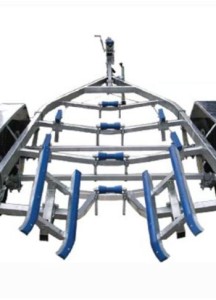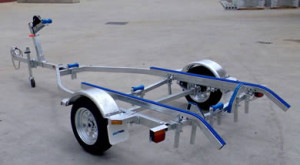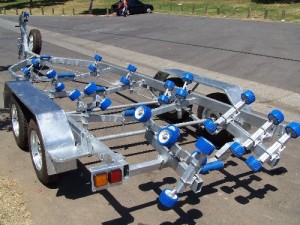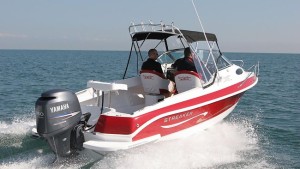Boat Trailer Tutorials
How To Set Up A Boat Trailer Correctly
How To Set Up A Boat Trailer Correctly
How to set up a boat trailer correctly – One of the biggest things that can make a difference to how you enjoy your day out on your boat can be how your boat trailer is set-up.
 How to set up a boat trailer correctly – Why is this you ask? As simple as it sounds, when your boat trailer is set-up correctly it will tow better, your trailer will sit behind your car better, it won’t swerve all over the road and naturally it will be a lot easier to launch and retrieve your boat on and off your trailer.
How to set up a boat trailer correctly – Why is this you ask? As simple as it sounds, when your boat trailer is set-up correctly it will tow better, your trailer will sit behind your car better, it won’t swerve all over the road and naturally it will be a lot easier to launch and retrieve your boat on and off your trailer.
Whats involved in setting up your boat trailer correctly and how to do it:
 How to set up your Boat Trailer covers things like boat roller and trailer skid set-up and positioning, when to use rollers and when to use skids. Learn how to position the boat on the trailer correctly and you will soon be spending more time in your boat than struggling with your boat trailer.
How to set up your Boat Trailer covers things like boat roller and trailer skid set-up and positioning, when to use rollers and when to use skids. Learn how to position the boat on the trailer correctly and you will soon be spending more time in your boat than struggling with your boat trailer.
First things first. Let’s start with the smaller trailers and work our way up to the medium to larger sized boat trailers.
Most 12 to14ft (3.7-4.3m) boat trailers come with fixed or welded on suspension, you won’t be able to move or adjust the position of the suspension. However, boats that fit on these smaller types of trailers are generally at the smaller and lighter end of the trailer market so don’t have a lot of draw bar weight so adjustment is generally not needed.
Once you get a boat trailer larger than 4.5m in size you may need to be able to adjust the suspension forward or backward which will allow you to attain the correct draw bar weight to make sure the trailer tows correctly. We will get to this topic shortly.
If you have too little draw bar weight the trailer won’t sit behind you when you are towing, instead it will tend to swerve or sway from side to side all over the road. It is possible to get into a situation where your trailer appears to sit behind you correctly, however when you go to overtake someone and pull back in front of them you’ll find the trailer wants to sway.
It’s not so bad if the trailer sways from the outset because you’ll notice the trailer swaying behind you and it will allow you to adjust your driving accordingly. The alternative situation is a more dangerous one because you may not notice the problem until it’s too late. If you aren’t experienced driving with a boat trailer and don’t know how to handle the problem of swaying it’s easy to roll the whole car and trailer over. Possibly the worst thing you can do is put your foot down on the brake. A better idea is to speed up slightly to get your trailer back into a following situation and then slowly let the whole trailer slow down to a manageable speed.
How Can You Solve This Issue?
The easiest way you can fix the swaying issue is by adjusting the suspension position further back on the trailer chassis. This will allow for an increase in the draw bar weight and will make the trailer follow the tow of the vehicle. Trial and error is the easiest way to determine how far you need to move it. In most cases it won’t be much, just make sure you place a marker where you started so you know how far you have moved the suspension.
Ultimately, you will want the draw bar weight to be substantial enough to get the trailer to follow your car at all times. If your trailer is too light the wheels will follow the road surface rather then your car and let the trailer will go where it wants. conversely if it is too heavy and then you’re in danger of overloading your trailer tongue on the car, it can make the front end of your vehicle too light. This can affect the steering of the car and cause damage to the suspension of the towing vehicle.
As a rule of thumb the standard was once that 10% of the weight of the trailer and boat was what you needed as draw bar weight. While this isn’t a bad measure for some boat sizes, it doesn’t work when the units are too heavy or too light. Imagine the following situation. A boat that weighs 200kg – that would mean there is 20kg of draw bar weight, which in reality would tow pretty badly. Now take something that weighs 5000kg; you would have 500kg of down force on your trailer tongue. Not a lot of people have tow bars that are rated for this weight.
Most tow bars have a maximum down force rating of 350kg. I haven’t seen too many trailers available with that sort of draw bar weight. The bottom line is that you should be able to tow your trailer/boat or caravan down the road at a minimum of 90km/h without the trailer swaying –and it should not sway when you overtake someone, as long as you stay under the legal speed limit.
How to LAUNCH AND RETRIEVE your boat: How To Setup A Boat Trailer
We will no discuss a couple of ways which will help make launching and retrieving your boat as easy as possible.
Small Boat Trailers
 Small keel roller trailers are often used for aluminium or fiberglass hulls and are reasonably quick and easy to set up if you have the right tools. When you set up your boat on your trailer it will need to be adjusted with a ‘nose up’ or ‘keel up’ angle, i.e. the boat’s keel needs to be set higher at the front than at the rear. This will allow the hull to roll off your trailer quickly and easily.
Small keel roller trailers are often used for aluminium or fiberglass hulls and are reasonably quick and easy to set up if you have the right tools. When you set up your boat on your trailer it will need to be adjusted with a ‘nose up’ or ‘keel up’ angle, i.e. the boat’s keel needs to be set higher at the front than at the rear. This will allow the hull to roll off your trailer quickly and easily.
- To do this, first set your trailer on a level ground. secondly, check that the front keel-supporting roller is higher than the back keel roller by approximately 25mm. Depending on what sort of trailer you have, for small sized trailers it is recommended that the cotton reel boat roller series supports this option perfectly. Sometimes you will need to make the front end a bit higher but usually 25mm will be sufficient. Just remember that its always easier to work without the boat being on the trailer.
- Next you need to get the boat sitting on its keel on the trailer. Move the boat forward until the rear end of the boat is overhanging the last keel roller by approximately 50mm. As a safety precaution make sure you adjust your trailers winch post to ensure your boat is secured to the trailer.
- The last adjustment you will need to do is to move the side support bunks in or out until they clear the strakes or pressings in of hull. Make sure you push them up until they touch the hull of the boat. You don’t need to have a large amount of weight on the side bunks as they are only really only there to keep the boat from rocking from side to side. Keel-type hulls and the associated rollers take approximately 60% of the weight, while the plastic bunks take approximately 40%.
Larger Boat Trailers
 When dealing with larger sized boats, the same set-up still applies for keel-type trailers. It’s much the same for multi-roller trailers without keel rollers, except that you’ll be making the appropriate adjustments with the roller packs on the outside of the trailer. The series of rollers and arms set up on the outer edge of a multi-roller trailer system are normally between 1100mm and 1200mm apart, and you just apply the same instructions as you would for a smaller sized boat.
When dealing with larger sized boats, the same set-up still applies for keel-type trailers. It’s much the same for multi-roller trailers without keel rollers, except that you’ll be making the appropriate adjustments with the roller packs on the outside of the trailer. The series of rollers and arms set up on the outer edge of a multi-roller trailer system are normally between 1100mm and 1200mm apart, and you just apply the same instructions as you would for a smaller sized boat.
- The back roller pack becomes your lowest point. You can then set the front roller pack higher than the back set by at least a minimum of 25mm; although up to 50mm can be accepted for larger boats. With these two packs set you can now adjust all the other packs lower and out of the way.
- Once you get the boat on the trailer and set it up for length; make sure there is approximately 50mm of the hull overhanging the last roller. As a note; Self Centering Keel Rollers can help guide your boat into the center and offer greater support to your trailer setup. Once you have adjusted the winch post, you can get down under the lowered roller packs with a trolley jack and use a jack to push the stems up until the roller packs are touching the hull of the boat.
- Once the rollers are touching the hull you’ll want to give the jack about half an extra stroke to get the roller packs to take up the main weight of the hull. Unlike keel-type trailers, multi-roller trailers will distribute the weight of the boat evenly over all of the rollers.
- Once you have completed one pack, repeat the same process on the rest of the packs on the other side of the trailer until all packs are adjusted accordingly and are sitting evenly over the hull of your boat. After you’ve made all the adjustments you may need to make a few minor tweaks here and there, but roughly 90% of the major work should be done.
The only other adjustment you may need to make is to adjust the individual arms in and out to clear the strakes of the hull. When you first get the boat on the trailer and you are pushing the roller packs up for the first time, you should be able to see if the rollers clear the strakes. If they don’t you will have to undo the U-bolts that hold the arms and slide the arms in or out to get the rollers to clear the strakes of the hull. We will cover this topic in an upcoming article on How to adjust boat trailer rollers.
As a caution you should consider when you’re adjusting things on your trailer is the brakes, you will need to make sure you don’t pull them or break any fittings when you make any adjustments. If you move the undercarriage of a wobble roller trailer there is a good chance it will be fitted with hydraulic brakes. You can tear the brake lines if you’re not looking to see how much adjustment you have in the lines. In most cases you can move your undercarriage approximately 200-300mm and the brake lines will allow it, anything over that you might have to check to see if it is capable of being moved any further without undoing some of the retaining clips that hold the brakes pipe in place. Any damage to the breaking system is a potential risk not only for you but also for other drivers on the road.
In conclusion, a properly set-up trailer will allow you to easily tow your boat to and from the ramps and allow you to launch and retrieve your boat without getting stressed, frustrated or even injured. It will make the roads a much safer place for yourself and the other road users. So make sure you take the time to set your boat trailer up correctly for your boat and you will be sure to spend many enjoyable years on your boat rather than struggling with your trailer. Just remember your boat will be different to your neighbours boat so keep in mind that your setup will most likely be unique to anyone you no.



